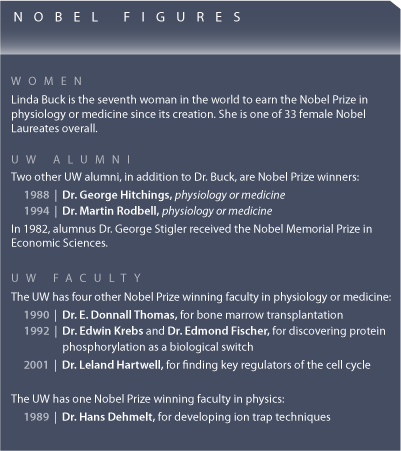Olfaction Studies Garner 2004 Nobel Prize
Dr. Linda B. Buck, member of the Fred Hutchinson Cancer Research Center's Basic Sciences Division, investigator of the Howard Hughes Medical Institute, and affiliate professor of physiology and biophysics at the UW School of Medicine, shared the 2004 Nobel Prize in medicine or physiology for discoveries of some of the underlying molecular mechanisms of the sense of smell. The Karolinska Institute in Sweden announced Monday, Oct. 4, that Buck and Richard Axel of Columbia University in New York City would receive the Nobel Prize for their 1991 findings on odorant receptors and the organization of the olfactory system. Buck was then a postdoctoral fellow in Axel's lab.
In describing the significance of this research, the Nobel Prize committee noted the survival value of olfaction for many species. Buck and Axel set out to answer the question, "How do we detect so many different odors?"
They looked in the nose for receptors that detect chemicals in the air. They then discovered how receptors are genetically encoded to identify specific odorants. People have some 350 olfactory receptor types, mice about 1,000. Buck and Axel found that a large group of genes encodes olfactory receptors. Buck later demonstrated that odors are recognized by specific combinations of receptors, much the way that a set of numbers forms a combination that unlocks a safe. The two researchers then went on independently to study how information about odors is gathered in the nose, the olfactory bulb, and the cortex. At each level, information is organized differently. The information obtained by olfactory receptors is randomly dispersed in the nose, organized in precise maps in the olfactory bulb, and then re-mapped in the cortex.
Buck is extending her studies to explore the role of smell in emotions, appetites, and behaviors, such as eating, mating, and mothering. She is trying to figure out why, for example, mice scurry to get at vanilla aromas, recoil from skunk spray, and freeze in alarm at fox scent. She is also studying factors that affect lifespan.
"UW Medicine congratulates Dr. Buck of the Fred Hutchinson Cancer Research Center and the Howard Hughes Medical Institute for her original, rigorous studies that led to being named a Nobel Laureate," said Paul Ramsey, vice president for medical affairs and dean of the UW School of Medicine. "We are very proud to have her as a faculty member of the medical school.
Dr. Ramsey continued, "UW graduate students and medical students are fortunate that Dr. Buck trains and mentors new researchers through her appointment as an affiliate professor of physiology and biophysics and her teaching in the UW Neurobiology and Behavior Graduate Program. She is also a valued colleague among UW scientists from many fields, including the neurosciences, genome sciences, anatomy and physiology, psychology, and molecular biology. Her seminal research discoveries have resulted in a new concept of how the important and varied sensation of smell is perceived and processed by the brain. "

A Seattle native, Buck earned bachelor's degrees from the UW in 1975 in microbiology and in psychology. She obtained a Ph.D. in immunology in 1980 from the University of Texas Southwestern Medical Center in Dallas. In 1991 she joined the faculty of the Department of Neurobiology at Harvard Medical School. She returned to her hometown in 2002, attracted by local excellence in research on the basic mechanisms of biological activities, especially in the nervous system.
Buck is the seventh woman to earn the Nobel Prize in physiology or medicine since its creation, and one of 32 female Laureates in any of the Nobel Prize fields.
Buck received the Nobel Prize Dec. 10 in Stockholm. Five other scientists affiliated with the UW have won Nobel Prizes in previous years, four in medicine or physiology and one in physics. They are: Dr. E. Donnall Thomas, recognized in 1990 for his work on cell transplantation in the treatment of human disease; Dr. Edwin Krebs and Dr. Edmond Fischer, honored in1992 for discovering reversible protein phosphorylation as a biological regulatory mechanism; and Dr. Lee Hartwell, who received the 2001 Nobel Prize for finding key regulators of the cell cycle. Dr. Hans Dehmelt received the 1989 Nobel Prize in Physics for developing the ion trap technique.
Buck has become one of four UW alumni to receive the Nobel Prize. Others were Dr. Martin Rodbell, physiology or medicine (1994), Dr. George Hitchings, physiology or medicine (1988), and George Stigler, (1982) economics.

Dr. Linda B. Buck